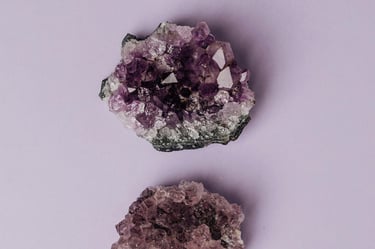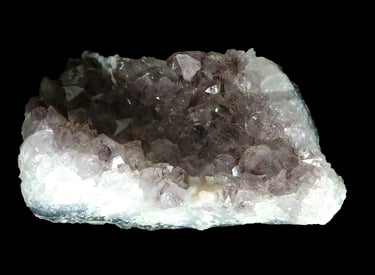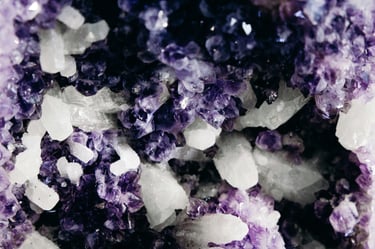Amethyst
Spiritual Protection · Clarity · Peace · Intuition · Sobriety · Divine Connection
Metaphysical Properties:
A powerful stone of spiritual protection and purification, Amethyst helps clear negative energy and attachments. It enhances higher states of consciousness and meditation, soothes the nervous system, and supports sobriety and clarity of mind. Amethyst brings calm, peace, and spiritual insight.
Symbolism & Associations:
Amethyst symbolises divine wisdom, balance, and spiritual awareness. It is often associated with peaceful energy, clarity, and emotional stability.
Chakra Alignment:
Resonates with Third Eye and Crown Chakras, supporting spiritual awareness & intuition.
Planets:
Jupiter
Zodiacs:
Pisces, Aquarius, Virgo, Capricorn
Elements:
Air
Water
Similar Stones:
Ametrine, Auralite, Purple Mica
Correspondences:
Colours: Violet, Purple
Crystals: Clear Quartz, Lepidolite, Black Tourmaline
Flowers: Lavender, Violet
Herbs: Sage, Chamomile, Lavender
Essential Oils: Lavender, Frankincense, Clary Sage
Incense: Lavender, Frankincense, Myrrh
Metals: Silver, Platinum
Months, Days, & Seasons: February, Thursday, Winter
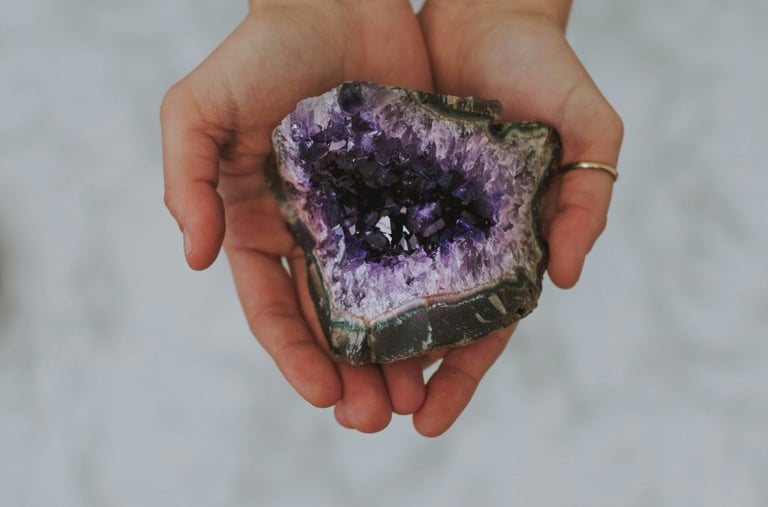



Facts
Stone Type:
Quartz variety
Hardness Rating:
7 – durable for everyday use, but may scratch softer materials or be scratched by harder ones.
Chemical Formula:
SiO₂ (Silicon Dioxide)
Care Guide
Amethyst is fairly durable and safe for everyday wear, but may fade with prolonged sunlight exposure. Clean using mild soap and water. Avoid harsh heat or ultrasonic cleaners.
Spiritual
Used to enhance meditation, spiritual protection, dream recall, and intuition. Amethyst can also act as a bridge to higher consciousness and spirit communication.
Healing
Said to help with headaches, sleep disorders, emotional stress, and addictions. Amethyst may ease anxiety, improve focus, and support the immune system.
Cleansing
Cleanse with smoke (sage, incense), moonlight, sound (tuning forks or bells), or under cool running water. Avoid sunlight for prolonged periods to preserve its colour.
Affirmations
“I am calm, centred, and at peace.”
“My intuition flows freely and guides me wisely.”
“I am divinely protected and spiritually aligned.”
“I release all that no longer serves me and welcome clarity.”
Meditation
Use Amethyst while visualising violet light above your head, expanding through your aura. Ideal for mindfulness, spiritual connection, and intuitive enhancement.
Astrology
Birthstone of February. Strongly connected to Jupiter and the zodiac signs Pisces, Aquarius, Virgo, and Capricorn.
Vibration
Amethyst carries a high, stable vibration especially attuned to meditation, and divine connection. Ideal for those seeking serenity, insight, and a stronger link to their higher self.
Did You Know:
In ancient Greece, Amethyst was worn to prevent drunkenness. The word “amethystos” literally means “not intoxicated.”
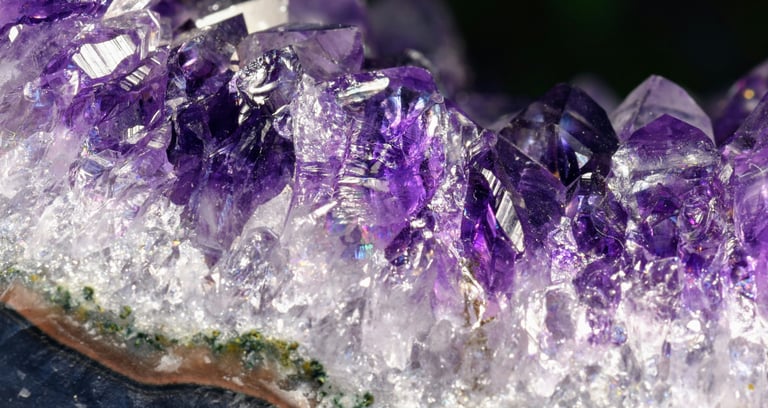

Mythology & Folklore
Amethyst is a crystal deeply rooted in myth and legend across many cultures. Its name is derived from the Ancient Greek word amethystos, meaning “not drunken,” and it was believed to prevent intoxication. The most famous myth comes from Greek mythology: Dionysus, the god of wine and revelry, was insulted by a mortal and swore vengeance. He vowed to unleash tigers upon the next human he saw. That unfortunate person was a maiden named Amethyst, who was on her way to pay tribute to the goddess Artemis. To protect her, Artemis transformed her into a pillar of clear quartz. Struck by remorse, Dionysus wept and poured wine over the stone, staining it a deep violet. From this tale, amethyst came to symbolise protection, divine connection, and sobriety.
In Roman mythology, similar beliefs prevailed, and goblets were carved from amethyst to prevent drunkenness. In Ancient Egypt, amulets made from amethyst were worn for protection against guilt, fear, and negative emotions. It was linked to the zodiac sign of the Goat (Capricorn), which represented the end of the intoxication cycle during Roman festivals.
In Tibet, amethyst is sacred to Buddha and used extensively in malas (prayer beads). Native American tribes considered amethyst a stone of the wind element, bringing clarity of mind, spiritual visions, and a connection to higher planes. It was also believed by some Celtic traditions to bring second sight and enhance psychic powers when worn or meditated with.
Historical Significance
Historically, amethyst held a place among the most valuable gemstones, often rivalling emeralds and rubies. Its regal purple hue was associated with royalty, power, and the divine. In ancient times, it was considered a stone of kings and priests. The Egyptian pharaohs and nobility wore amethyst in signet rings and amulets. In ancient Rome, it adorned the fingers of statesmen and generals, believed to grant them clarity of thought and protection in battle.
During the Middle Ages, the Catholic Church adopted amethyst as a symbol of piety, humility, and celibacy. Bishops traditionally wore amethyst rings as a reminder of spiritual responsibility, and many of these rings were passed down for generations. It became known as a “Bishop’s Stone” and still features prominently in religious iconography today.
Amethyst was also used in medieval healing practices. Physicians would crush amethyst into powder to treat everything from headaches and insomnia to snake bites and fevers. It was worn over the heart to ease grief and sadness, and placed under pillows to guard against nightmares and promote prophetic dreams.
In the Renaissance, royalty and aristocracy across Europe continued to favour amethyst for both its elegance and protective properties. It was used in royal sceptres, crown jewels, and altar pieces, including those in the British Crown Jewels.
Today, while amethyst is more accessible due to discoveries of large deposits, especially in Brazil and Uruguay, its spiritual and historical significance has never waned. It remains a symbol of wisdom, spiritual insight, and calm, used worldwide in energy healing, meditation, and sacred ritual.
Origin & Formation
Amethyst is a variety of quartz (SiO₂) known for its captivating purple hues, which range from grey to pale lilac, all the way to deep violet. Its characteristic colour comes from natural irradiation and the presence of iron (Fe³⁺) and trace elements within the quartz crystal lattice. When exposed to gamma rays from radioactive decay in the Earth over millions of years, these trace elements interact to produce amethyst’s signature violet tones. The depth of colour is influenced by the amount of iron present and the level of radiation exposure.
Amethyst typically forms in geodes, hollow rocks lined with crystals that develop over millions of years in volcanic environments. These geodes begin as bubbles of gas in lava flows, which gradually fill with mineral-rich water. As the water cools and evaporates, silica crystallises into quartz, and under the right conditions, amethyst begins to form. The inner surfaces of these geodes become lined with sparkling purple crystals that can grow up to several inches long. Some of the largest amethyst geodes ever found, such as those from Artigas, Uruguay, and Rio Grande do Sul, Brazil, stand over 10 feet (ca. 3 m) tall and contain thousands of perfect points.
Amethyst can also form in hydrothermal veins—fractures and cavities deep within the Earth’s crust where mineral-rich water flows through cracks under high temperature and pressure. In these settings, amethyst may crystallise alongside other minerals such as calcite, hematite, and smoky quartz.
Significant amethyst deposits are found worldwide. Brazil and Uruguay are major sources, producing large geodes with high transparency and rich colour. Zambian amethyst is renowned for its deep, saturated purple with blue undertones. Russia’s Ural Mountains once produced highly prized stones with a reddish-purple hue known as “Siberian Amethyst,” considered the finest quality historically. Other sources include South Korea, India, Madagascar, Sri Lanka, Bolivia, the United States (especially Arizona and North Carolina), Canada, and Austria.
Some amethyst specimens exhibit interesting growth patterns and inclusions, such as chevron banding (alternating layers of white quartz and purple amethyst), which can enhance their metaphysical appeal. In addition, amethyst may occur in combination with other quartz varieties, such as citrine, resulting in the naturally bicoloured gemstone known as ametrine.
Despite its relative abundance today, amethyst’s formation process is both delicate and rare in geological terms. Only specific environmental conditions—stable temperatures, volcanic activity, and precise chemical balance—can produce this beloved gemstone in its natural, unenhanced state.


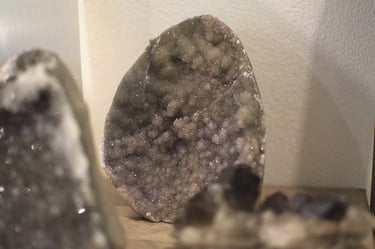

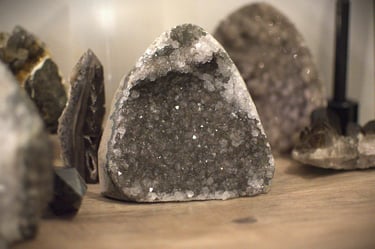

Variation & Quality
Amethyst displays a wide spectrum of purple tones—from soft lavender to deep, royal violet—caused by trace amounts of iron and natural radiation in its crystalline quartz structure. The intensity and hue depend on the local environmental conditions during formation. Deep, saturated colours with flashes of red or blue are typically the most prized, such as the highly valued Siberian Amethyst.
There are several unique varieties of Amethyst, each offering distinct visual characteristics and energetic nuances:
Black Amethyst: Featuring darker, deeper purple tones often tinged with black or smoky shades, this variety of Amethyst is highly regarded for its grounding and protective properties. It is said to help with purification, absorbing negative energies, and providing a deep connection to the Earth.
Grey Amethyst (also known as Silver Amethyst or Smoky Amethyst): A unique and understated variety that blends soft lilac tones with a silvery-grey or smoky hue. Whilst less vivid in terms of colour, it carries calming, grounding energy, ideal for emotional regulation, inner stability, and gentle spiritual protection. Grey Amethyst is particularly supportive during grief or emotionally intense times.
Pink Amethyst: With soft pastel pink hues, Pink Amethyst is a more recent discovery, often found in Argentina. This variety is known for its calming and soothing energy, promoting emotional healing and self-love. It's often used to alleviate stress, anxiety, and negative emotions, while fostering a sense of peace and compassion.
Lilac Amethyst: A lighter, softer shade of Amethyst that typically has pale violet to lavender hues. This variety is associated with relaxation, peace, and emotional healing. It is believed to aid in calming the mind and promoting a peaceful environment, making it ideal for meditation and stress relief.
Chevron Amethyst: Recognisable by its striking V-shaped bands of white quartz and purple Amethyst, this variety blends clarity and intuition. It's often used for visioning, inner work, and aligning higher consciousness with grounded insight.
Vera Cruz Amethyst: Slender, clear, pale-violet crystals from Mexico, known for their exceptionally high vibration and fast-acting crown chakra stimulation. Often used for astral travel, lucid dreaming, and connecting to angelic realms.
Spirit Amethyst (also known as Cactus Quartz): Covered in tiny druzy points over a central crystal, this sparkling variety from South Africa is associated with community healing, unity consciousness, and spiritual attunement. Its energy is high-vibration, playful, and deeply cleansing.
Sugar Amethyst: Named for its sugary, crystalline texture, Sugar Amethyst is typically covered in a fine layer of tiny crystal points, creating a sparkly, “sugary” effect. This variety is associated with uplifting, joyful energy, and is typically used to bring positivity, ease, and happiness into one's life. While it predominantly occurs in shades of purple, you might also find it in variations of lighter lavender, deeper violet, or even rarely, black, as illustrated in the photo we've included above. The colour depends on the specific mineral content and environmental conditions during formation.
Brandberg Amethyst: Mined only in Namibia’s Brandberg region, this rare and highly sought-after crystal frequently contains clear quartz, smoky quartz, enhydro inclusions (water bubbles), or phantoms. It is treasured for its high frequency, purity, and ability to support deep soul work and trauma healing.
Phantom Amethyst: Displays internal layers or ghost-like “phantoms” marking earlier growth stages. These suggest personal evolution, healing through past lives, and clearing ancestral or karmic patterns.
Dream Amethyst: Dream Amethyst is known for its soft, misty appearance and gentle energy. This variety often features translucent, cloudy layers within the crystal, which creates a peaceful, dreamlike quality. It is highly connected to the Third Eye and Crown Chakras, supporting meditation, dream work, and spiritual clarity.
Auralite 23: A rare form of Amethyst found in Canada, Auralite 23 is highly prized for its exceptional energetic properties. It contains 23 different minerals, including Amethyst, and is known for its ability to facilitate deep spiritual healing and transformation. It is said to promote connection with higher realms and assist in clearing negative energy.
In terms of grading, high-grade Amethyst has strong, saturated colour, excellent clarity, and minimal inclusions. Mid-grade stones may show uneven colour or cloudiness, while lower-grade material can appear pale, brownish, or overly included—but all retain Amethyst’s signature vibration. Most Amethyst is natural, but lower-quality material may be heat-treated or stabilised for enhanced colour..
Notes
Amethyst, often regarded as the “stone of spiritual growth,” has been highly valued for centuries in various cultures for its healing and protective qualities. Known for its calming energy, amethyst is often used to promote mental clarity, emotional stability, and spiritual awareness. It is a popular choice in meditation practices, as it assists in focusing the mind and connecting with higher consciousness.
Amethyst is frequently paired with other stones, such as clear quartz for amplifying energy, rose quartz for emotional healing, and citrine to promote abundance and joy. These combinations create a balanced energetic field, addressing different aspects of physical, emotional, and spiritual well-being.
In boho and goddess jewellery, amethyst is highly regarded for its soothing and protective energies. It is often worn by those seeking peace and clarity, especially during periods of emotional difficulty or transformation. Its vibrant hues also make it a popular choice in crystal grids, where it serves as the primary stone for spiritual work or healing.
For cultural significance, amethyst has been historically linked to the ancient Greeks and Romans, who believed it could protect against intoxication. The name “amethyst” itself comes from the Greek word “amethystos,” meaning “not drunken.” In these cultures, the stone was often worn or placed in drinking vessels to ward off the effects of alcohol.
For care, amethyst is relatively easy to care for, though it should be kept away from direct sunlight for extended periods, as this can cause the colour to fade. Cleaning can be done with a soft cloth and lukewarm, soapy water—avoid harsh chemicals or ultrasonic cleaners. While amethyst is moderately hard (Mohs hardness of 7), it should still be handled with care to avoid scratches or chips, particularly if it has been tumbled or polished.
